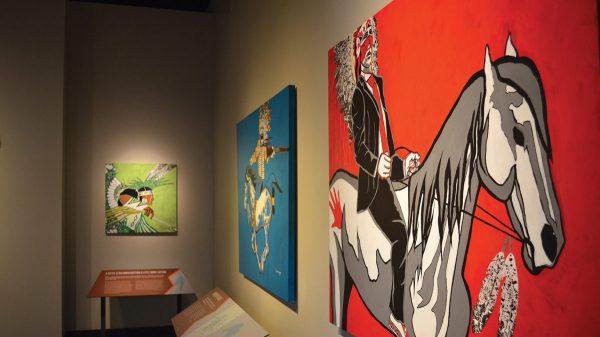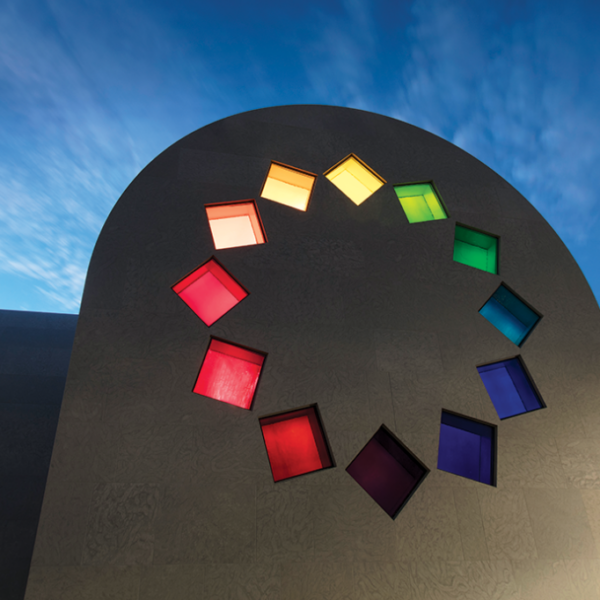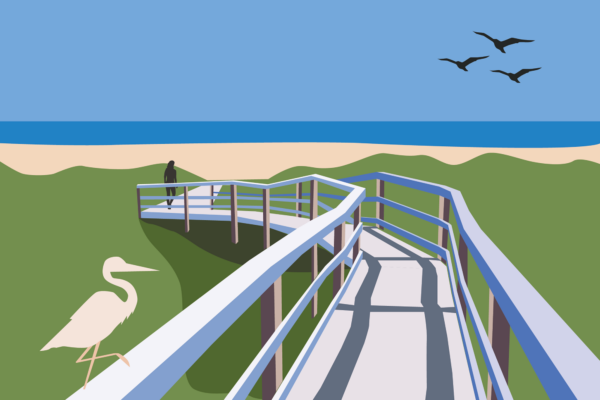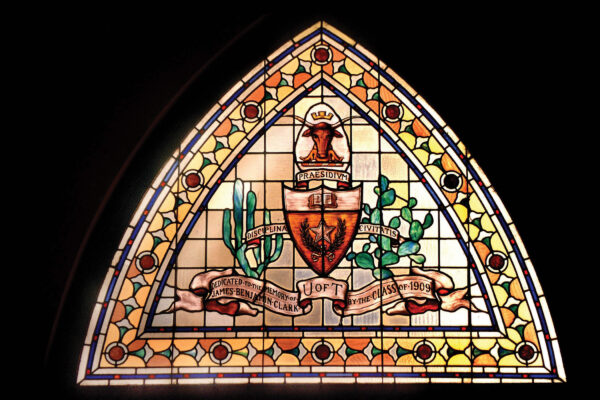Blanton Museum of Art
Before you even get into the Blanton Museum of Art, Ellsworth Kelly’s Austin catches your eye. The architecture is so minimal, yet stunning. The separate stone structure serves as an imposing introduction to the museum’s vast collections.
The easiest way to understand the Blanton Museum is to break it down into two floors.The ground floor holds the Butler Gallery, where temporary exhibitions are located. The top floor holds the permanent collection galleries.
Carlotta Stankiewicz, the marketing and communications director, and Penny Snyder, the PR and media manager, both stated that this constant rotation keeps galleries fresh and new for visitors all year.
“Just because you’ve been to Blanton once…” Stankiewicz said. “…does not mean it’s going to be the same,” finished Snyder.
The spotless white of the building, the sparkling pennies on the ground, the multiple hues of blue on the staircase. If you’ve seen it all before, you will want to see it again.
What to see
Rotating galleries include paintings from the pre-Columbian era to contemporary pieces. They are displayed in three to four rooms and change regularly.
The newest exhibit will open in February. Words/Matter will display a selection of the Blanton’s Latin American collection of art and will include present-day works and ones dating to the 1920s. It focuses on artists who use language in their artwork, from making up a language completely to even mail art that artists would send to each other.
Staff and faculty members can always enter free, but every Thursday is free to the general public. Staff and faculty members get in free with one guest.
What to do
The Blanton is hosting a lunchtime lecture series on Ellsworth Kelly, creator of the Austin. The focus of the series will be Kelly and different aspects of his artistic practice, along with elements that have influenced that practice during his lifetime.
There are other monthly lunchtime staples. Midday Music, a concert in conjunction with the Butler School of Music, happens on the fourth Tuesday of every month. On the third Thursday of every month, the Blanton hosts a public tour at 12:30 p.m., typically covering the permanent collection. These tours sometimes include gallery talks that provide a more interactive and in-depth peek into an artist’s message.
There are some beloved, iconic works in the Blanton that are on long-term display such as a work by Brazilian conceptual artist Cildo Meireles called Missão/Missões [Mission/Missions] (How to Build Cathedrals), a cathedral of pennies and bones representing a criticism toward the practice of religious conversion in colonial Latin America; and the permanent and hard-to-miss Stacked Waters, an intense piece that covers the entirety of the Blanton’s staircase. Staff and faculty members can enjoy these trademark works at any time.
Kelly’s Austin has also quickly become an icon of the Blanton, and it is permanently at the museum. Staff members speak highly of its calming effect on visitors.
“Just come during your lunch and chill and have a moment of zen,” Stankiewicz said. “There’s benches in there, so you can go in and sit and look at the light coming in through the windows and meditate or just kind of sit and think.”
Don’t miss this
A unique part of the Blanton is the Paper Vault, the source of at least one exhibition every year. Curators get to choose from nearly 15,000 paper art works that the museum has in storage. Unlike other exhibitions shown in the Blanton that may include artifacts or digital aspects, this exhibit rotates every three to four months.
“The thing about works on paper is they have a short life,” said Stankiewicz. “They degrade easily. They’re paper. And so they can only be shown for a certain amount of time. Other than that, they’re in the dark.”

Harry Ransom Center
One word to perfectly describe this museum is layered. Most people who enter come in expecting a museum, but that’s not all that they get. They also get an archive library, a performing arts center, a photo gallery.
Since they are on a college campus, the exhibits of the Harry Ransom Center roughly follow the same calendar as the academic school year; there is a fall thematic exhibition and a spring thematic exhibition.
Lisa Pulsifer, the head of education and public engagement, said that this schedule allows for continuity.
“One of the great things about having the two distinct areas for exhibitions is that we’re always able to have at least one of them on display,” said Pulsifer. “So nearly the entire year, any time someone comes in from the public or from campus, there will be something to see in our galleries.”
What to see
Stories To Tell is a special exhibition that highlights displays from all of the center’s collecting areas including literature, film, photography, performing arts and art. This display changes about a week after the main exhibits.
Pulsifer said that the purpose is to display more variety than surrounding museums do and to highlight what makes the Ransom Center unique.
“So, if the main thematic exhibition is more photography or art based, we’re able to still show some of our highlights in our collection that might appeal to staff across the campus in those displays in Stories To Tell,” said Pulsifer.
These exhibits are planned to pair nicely with the center’s schedule of guest speakers that frequent the halls, as well as to reach a wide audience.
“For the most part, [Stories To Tell] are ways to highlight some of the stories that are timely,” Pulsifer said. “We really hope that there’s something for everyone this way. No matter what your background is, there’s such a variety of collection items in the galleries that it would appeal to people.”
THE ENTIRE YEAR, ANYTIME SOMEONE COMES IN FROM THE PUBLIC OR FROM CAMPUS, THERE WILL BE SOMETHING TO SEE IN OUR GALLERIES.
What to do
The Harry Ransom Center offers a free public tour every day at noon. Staff or faculty members with classes can even book private tours. “I know that we get a lot of repeat visitors who I see come to every exhibition,” said Pulsifer. “Once they start getting familiar with us and our tour program, it’s not uncommon that they’ll want to come back and see the next exhibition.”
There are also classrooms available for faculty and staff members to use to access the archive library. Upon request, staffers can even set up classrooms with archive library materials specific to the particular lesson.
The Ransom Center regularly brings in guest speakers, shows films or plays in the adjacent theater, and has panel discussions regarding work on display or topics those works cover. Once or twice a year, the Ransom Center will host a series of poetry readings given by various speakers just outside the front entrance. This daytime pleasure is surely a must see for anyone who loves the spoken word.
Don’t miss this
Pulsifer highly recommends the center’s original Frida Kahlo painting on display.
“It’s amazing. It’s a beautiful painting. It’s really special that we’re able to show that to everyone,” said Pulsifer. “She’s got such name recognition, of course, but beyond that, when you’re standing in front of it, it’s such an intimate piece where you’re kind of confronted with her and her face and just … it’s a beautiful painting.”

Bullock Museum
The first thing you notice is the star. A lone star in the distance that reminds you so much of Texas that it’s impossible to forget what this museum is all about. The next thing you notice is the entryway, a perfect cylindrical arch with a staircase that leads up, up to hopefully something magical. That’s usually about the time someone says hello. I think the staff of the Bullock Texas State History Museum does this best: wraps you in a warm blanket of Southern hospitality as you set off to learn more about a state rich with more history than some countries.
Kate Betz, the deputy director of interpretation, is adamant that what the museum offers is more than just a history lesson.
“We are not an encyclopedia of Texas history,” said Betz. “But rather we are a place where you can come and see a thing and make a connection with that thing, and then use that to make a connection with history and your own life.”
What to see
The current installation, Becoming Texas, uses artifacts from the Bullock Museum itself to physically display the history of Texas, from the beginnings of human habitation 16,000 years ago to present day.
2019 brings the premiere of Texas From Above, an exhibit of aerial photography taken along the Texas borders, and an exhibit opening in March called World War One: America.
“What I think is really interesting about [this exhibit] is it’s not an attempt to tell the story of the battles and what’s happening in Europe. It’s more of a chance to talk about what’s happening in the United States on the homefront during the war and what dramatic changes to our society, culture, politics, etc., were reaped as a result of the war,” said Betz.
The Bullock also hosts speakers and performers as part of the Texas Artist Series. This unique program highlights artists and experts with Texas influences.
“This is a program I’m really fond of,” said Emily Morris, the museum’s marketing manager. “I really enjoy it because we have an expert or an artist come in and discuss their craft, and that’s been reallyreally interesting.”
“And we’ve been trying to diversify what people think of with the word ‘artist,’ ” added Betz.
What to do
High Noon Talks happen at the Bullock on the first Wednesday of every month, and the discussions usually center on some element of Texas history or culture.
“It’s a really fun, informal setting,” said Betz. “The presenter will give a short talk, and then there will be questions and answers following. Sometimes it’s like a brand new scholar’s book that is being published; sometimes it’s just a really fun story. We’ve had the daughter of the founder of Whataburger come out and talk about [its] founding.”
“You can come during your lunch break and kind of step away from campus,” said Morris about High Noon Talks.
Don’t miss this
The Bullock is perfect for faculty and staff members who have kids. It holds two programs a month for young ones: Story Time on the fourth Thursday of each month and Little Texans on the second Thursday of each month.
“These are intended to help kids and their adult caregivers figure out how to use and enjoy a museum,” said Betz. “So they’re themed every month, and it’s all about scaling an exhibit to a level that your kid is going to enjoy. So you don’t have to come in and talk about all of the facts of the Texas Revolution; instead you could say, ‘We’re going to do a program about hats today, and we’re going to walk through the gallery, and we’re going to try and find every hat that we can, and we’re going to talk about who might wear that hat.’ Something really simple like that.”



